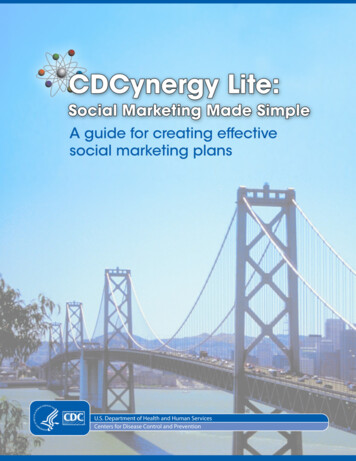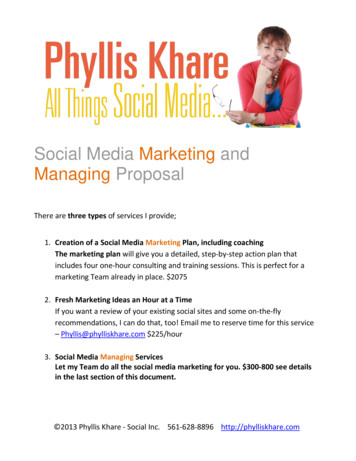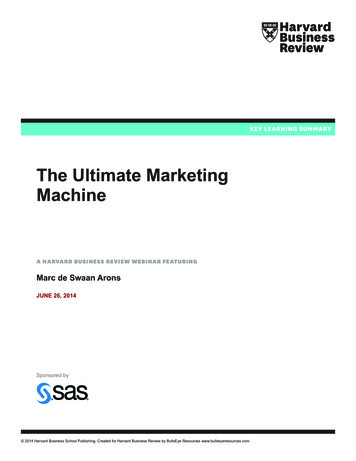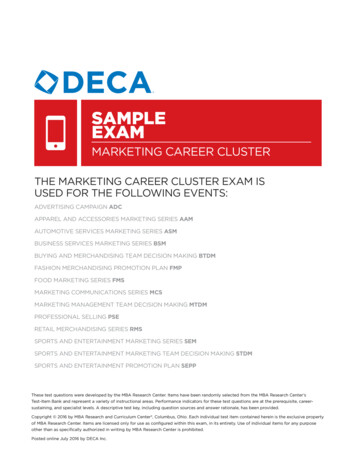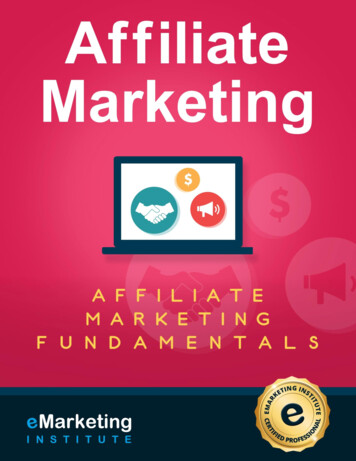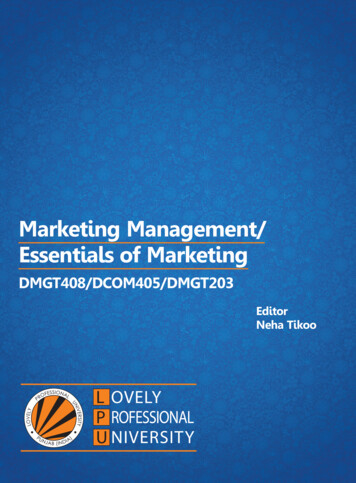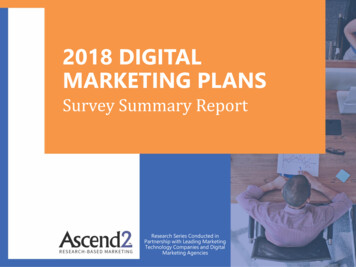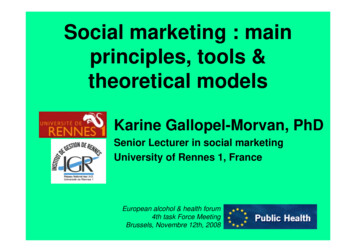
Transcription
Social marketing : mainprinciples, tools &theoretical modelsKarine Gallopel-Morvan, PhDSenior Lecturer in social marketingUniversity of Rennes 1, FranceEuropean alcohol & health forum4th task Force MeetingBrussels, Novembre 12th, 2008
Karine Gallopel-MorvanPhD, Senior Lecturer in social marketingUntitled to supervise thesisGraduate School of business administration, University of Rennes 1 France Research activities:– Social marketing– Tobacco control & alcohol prevention (warnings,tobacco plain packaging, industry marketing tactics)– Scientific Journals, books, conferences Working groups:– Member of the working group to implement the« Etats Généraux de l’alcool » in 2006, healthMinistry, France– Member of the working group to elaborate guidelinesfor the article 11 (FCTC, WHO, Manilla, nov 2007)
Aim of the presentation Europe’s drinking habits cause around195,000 premature deaths every year Can social marketing be helpful ?
« Social marketing is a process thatapplies marketing principles, toolsand techniques to create,communicate and deliver value inorder to influence target audiencebehaviors that benefit society (publichealth, environment ) »Kotler and Lee (2008), Social marketing, Sage.
Social marketing :tools & principles 1- Consumer research / analysis of theenvironment 2- Applies segmentation & targeting 3- Sets objectives & goals 4- The « 4P » : Product, Price, Place &Communication 5- Evaluation of the program
1- Consumer research /analysis of theenvironment
Tools that allow to better understandpeople & environment thus, smprograms are more effective– Review of the litterature– Observation of the market & competitors– 33 focus groups– 40 in-depth interviews– Face to face survey (800 teenagers 601young adults 404 parents)– On teenagers, young adults & parentsJones & Rossiter (2002), Social Mkgt Quarlerly
Ex: Alcohol, binge drinking & students20 In-depth interviews, Rennes, France« COSTS »Car accidentLoss of driving licenceLoss of memoryHard following day« BENEFITS »PleasureTo have funTo do like friendsTo speak easily withunknown peopleTo forget problemsNot dangerous for health
Reasoned action theoryBinge drinkingbehavioral intentionAttitude toward productSubjective norms (social norms)Not dangerous for healthTo do like friendsFishbein M., & Ajzen I. (1975, 1980)
To change Attitudetoward product
To change social norms It is not a shame not to drink alcohol
Observation of the marketA very competitive environment for social marketingprograms1,4 billion Euros a year on alcohol advertising
2001 - Castelbajac2002 - Christian Lacroix
SponsoringAlcoholic beveragesfor young people :sweet & soft
Positive impact of alcohol advertisingexposure on young people Snyder & alii. (2006), Effects of alcohol advertising exposure on youthdrinking, Arch Pediatr Adolesc Med.Ellickson & alii. (2005), Does alcohol advertising promote adolescentdrinking? Results from a longitudinal assessment, Addiction.Wyllie & alii. (1998), Positive responses to televised beeradvertisements associated with drinking and problems reported by 18to 29-year-olds, Addiction.Woodside (1999), Advertising and consumption of alcoholic beverages,Journal of Consumer Psychology.Dring & Hope (2001), The impact of alcohol advertising on teenagers inIreland, Centre for health Promotion Studies
2- Segmentation and targeting people are unique, this means asocial marketer must offerdifferent programs for differentpeople. Segmentation improves the quality of healthprevention programs.
Several segmentation criteria canbe used
Stage of change ortranstheoretical model Developed in the 1980s by Prochaska &DiClemente people go through to several stages beforechanging their smoking behavior:
your body never forgetsall what you drinkIf you drink more than3 glasses of alcohola day for men and 2 glassesfor women,the risk of developing cancers increases
Sex
Young people&alcoholAgeDon’t drinkif you drive
Ethnicity
Other targets influencers :––––Parents for teenagersHealth practitionersOpinion leaders (singers, sportmen/women )Journalists
3- Set objectives & goals
Ex: alcohol program To change targets’ behavior– Ex: in 1 year, to decrease of XX% the number of menthat drink more than 3 units of alcohol per day– In 3 years, to reduce alcohol-related harm of XX% onpeople 18-24 year-olds To increase information on negativeconsequences of drinking To move social norms Objectives must be realistic & measurable
4- The 4 P
Product in social mkgt (what) A « real » product :breathalyzerbrochures
A service :– Medical consultation– Alcohol weaning
A behavior & value :––––Not to drink more than Not to drink when pregnantNot to drink when driving – To enjoy life without alcohol– Alcohol is not the norm–
brand of asocial marketing product ?(Florida campaign, USA) A model of effective social marketing campaign 1 year after : smoking among students declined: 29 000 fewerFlorida teens smoked
NATIONAL ALCOHOL CAMPAIGN, AUSTRALIA,2000 A brand for parents : « Talk to your kids aboutsafe drinking » A brand for teenagers : « Safe drinking »Jones & Rossiter (2002), Social Mkgt Quarlerly
Price (how much) Price for real product & service (money) Price in social marketing non monetarycosts to give up a behavior : Pleasure, partyto have funTo do liker friendsto speak easily withunknown peopleTo forget problems The exchange theory
Place (where) SM product mustbe available inrelevant placesBrochures foryoung peoplein schools,colleges Ex: breathalyzers in bars& nightclubs
PromotionAdvertising message
The persuasion processMcGuire (1989)1- Exposure2- AttentionImpact onbehaviorAdvertisement3- Understanding4- acceptance5- recall
1- ExposureArgo & Main (2004)
Fischer & Al (1993)
2- Attention how to pay attention of the target ?– Alcohol prevention messages have tocompete with crowded media place (peoplesee about 2000 ads per day numerous adsfor alcohol products)– prevention messages need to make a strongimpact otherwise they won’t be seen
The power of illustration to attract attentionSam doesn’t drink & drives
Thanks to alcohol,all eyes are on you
The power of emotional ads Research in marketing showed :– Informative advertisements are not as effectiveas emotional campaigns (positive & negativeones : shame, guilt, fear .)Edell & Burke (1987, 1989), Petty, Cacioppo & Schumann (1983)Witte & Allen (2000)
The Protection Motivation ModelRogers (1975, 1983)Pictures, testimonials Efficacy of the proposed response Self-efficacy of the proposed response Motivation to protectsuccess of the campaign
Ex : fear Thanks to alcohol,you meet new people
Ex : shame Alcohol brings out thebest in you
Ex :fear / shame self-efficacy– The 4 Thursday nights : festive alcohol-free events,open to all and free of charge(Music, Sport, theatre, barswithout alcohol ).
Ex : fear / shame efficacy
3- Understanding« moderation ? »
4- Acceptance Acceptance (and effectiveness) of aprevention message from industry ?– Corporate social responsibility : messages canbackfire if people question the organization’smotivations (Yoon & al., 2006, Peter & al, 2007, Szykman & al, 2004)– Social responsability campaigns are counterproductive in a tobacco context (Donovan & al., 2006, Farrelly& al, 2006, Wakefield & al, 2006), – Alcohol ?
Alcohol CSR problem of source credibility(trust) Extract from the deontological code,alcohol industry in France : « Commercial adsshall never : be spread in print media that targetsyoung people (under 18) » Evin Law, 1991 : regulates the advertising ofalcoholic beverages to protect minors
Ex of alcohol ads in a magazine that targets young people Ciné Live (dec 2007)leader on 15-24 (sales)53% of readers 15-24 ans
Ex of forbidden ads
Media :How to reach the target audience ?
Mass mediaTV, radio, print, billboard, cinemaEventsWebsite & Viral CampaignPressrelations
Ratio of alcohol prevention messages is needed 4 positivetobaccomessagesfrom tobaccoindustry 1 antitobaccomessage tobreak Lewit, Coate & Gosssman (1981)
5- Evaluation
Come back to the objectives To change targets’ behavior– Ex: in 1 year, to decrease of XX% thenumber of men that drink more than 3units of alcohol per day– In 3 years, to reduce alcohol-relatedharm of XX% on people 18-24 yearolds To increase information onnegative consequences of drinking To move social norms
Conclusion Advertising messages are only one aspectof a comprehensive social marketing alcoholprogram A real social marketing program in Europe a « FCTC » for alcohol Social mkgt programs take time and needsignificant resources
References SM Andreasen A. R. (2005), Social Marketing in the21st century, Sage publications. Andreasen A. R. (1995), Marketing SocialChange, Jossey-Bass Publishers, SanFrancisco. Gallopel-Morvan K., Birambeau P., Larceneux F.et Rieunier S., Le Marketing et laCommunication des associations (marketing &communication for NGOs), Dunod, 2008. Hastings G (2007). Social Marketing: WhyShould the Devil Have all the Best Tunes?Butterworth-Heinemann. Kotler P., Lee N. (2008), Social Marketing :Influencing behaviours for Good, SagePublications, 3rd edition.
Thank you for your attentionIf you want some references, contact meat :karine.gallopel@univ-rennes1.fr
This paper was produced for a meeting organized by Health & Consumer Protection DG and represents the views of its author on thesubject. These views have not been adopted or in any way approved by the Commission and should not be relied upon as a statement ofthe Commission's or Health & Consumer Protection DG's views. The European Commission does not guarantee the accuracy of the dataincluded in this paper, nor does it accept responsibility for any use made thereof.
PhD, Senior Lecturer in social marketing Untitled to supervise thesis Graduate School of business administration, University of Rennes 1 France Research activities: – Social marketing – Tobacco control & alcohol prevention (warnings, tobacco plain packaging, industry marketing tactics) – Sci
